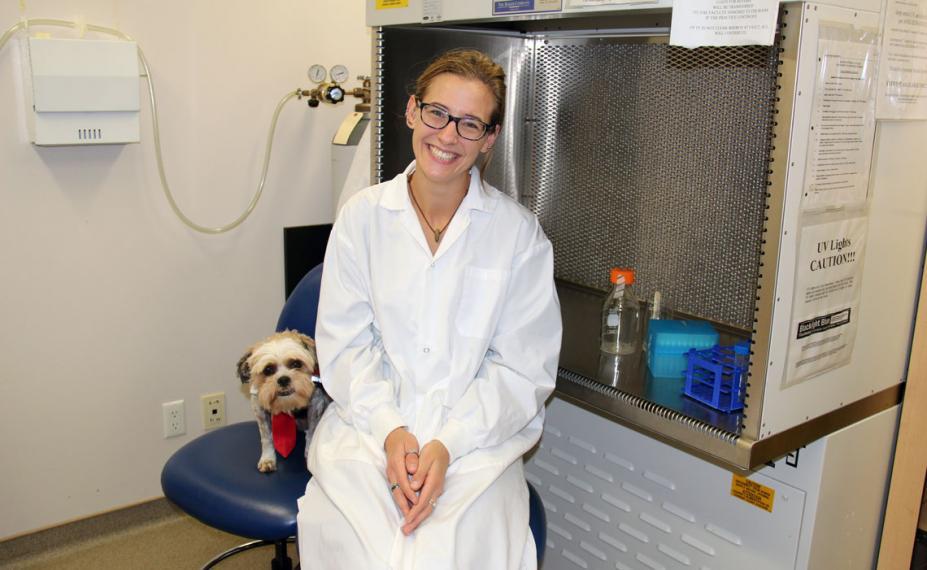Straight from the horse’s stomach

Horses are highly-adapted performance animals, but one unexplained adaption – a very delicate gastrointestinal tract – is their Achilles heel.
Like humans, horses’ stomachs contain acid to digest and break down their food and mucus to protect the stomach wall against the acid. But for a vaguely inexplicable reason, horses do not have mucus on the top half of their stomachs. This causes all sorts of issues, including gastric ulcers.
In fact, gastrointestinal diseases are the leading cause of death in horses.
“If acid splashes up, or their stomach is empty, it can really damage a horse’s stomach,” explains Jennifer MacNicol, a PhD candidate in the Department of Animal Biosciences. “But what if we can keep food in there longer and potentially buffer that splashing, or use nutraceuticals to reduce acid production or increase mucus production?”
Jennifer’s PhD focuses on equine gastrointestinal physiology. She’s working with Prof. Wendy Pearson to “determine what makes a horse’s gastrointestinal tract tick”, and investigate the effectiveness of nutraceuticals proposed by industry.
“One of the big GI diseases in the horse world is ulcers. It’s a popular topic,” Jennifer explains. “What I want to look at is, can one of these nutraceuticals prevent how quickly things move through the stomach?” Because if we can slow this down a little bit, we might be able to create a buffer.”
Jennifer explains that the faster things move through the stomach, the more exposed the stomach is to acid and leads to ulcers.
“If we can influence that contraction and mixing through nutraceuticals, we might be able to change that disease process.”

Jennifer is also working to create an in-vitro protocol as part of her research work. The hope is to be able to test these nutraceuticals prior to animal trials.
An in-vitro protocol is essentially a chemical breakdown protocol that simulates the different compartment of a stomach. “We put it through a process that simulates the digestion,” she explains.
The result will hopefully be a less invasive way to conduct equine research.
“I think as scientists we have an obligation that if we use live animals, we need to make sure they are the most directed and valuable studies,” she explains. “Even if it is not a terminal study, it’s still invasive. I want to develop strong and robust in-vitro methods so that we can do a lot of things before taking it into the live animal.”
Jennifer will lean on Prof. Pearson’s experience, as she’s developed an in-vitro simulated digest.
“She’s shaped a lot of my love and views on in-vitro work,” shares Jennifer. “She’s a great resource for me.”
Jennifer also pursued her MSc with Prof. Pearson, but focused on the influence of high intensity exercise on the profile of oxidative stress in the blood, as well as in joint fluid. They looked at the effects of antioxidant intervention in reducing post exercise inflammation.
“Inflammation is an important process for protection and adaptation. We were looking at what happens in the joint, inflammation wise, after high intensity exercise. How does that peak, how much does it peak, when does it come back down? It gives us ideas on when we could have pointed interventions,” she explains.
Before her master’s, Jennifer completed her Bachelor of Science in animal biology in 2015 also at the University of Guelph.
Jennifer’s love of horse started at a young age. She grew up in Mississauga, rode horses and competed in hunter-jumper. She later worked as a groom on the competitive circuit.
At University, she started her undergrad in human kinetics, but found herself fascinated by an animal metabolism course taught by Prof. John Cant.
“I thought it was the coolest thing ever,” she says. “I loved the metabolism and the physiology. He talked about research in the course, and that got me really interested in research. I took the research literature review course and I loved it. I read all of these papers and I wanted more and more and more.”
Her love of research has blossomed into one that’s been recognized by a key federal research funding agency.
This year, Jennifer was awarded a prestigious Vanier Canada Graduate Scholarship through the Natural Sciences and Engineering Research Council for her PhD research.
“The scholarship gives me autonomy,” she explains. “It’s amazing because I can just focus on my research, and it gives my supervisor the ability to focus on the research. We are very lucky that NSERC is supporting its’ young scientists in this way.”
The Vanier scholarship is worth $50,000 per year for up to three years.
“I get so excited because there is so much you could do with horses,” she shares.
“I love research. I am really excited to see what happens and I want to keep becoming a better scientist. Become better at designing experiments and asking poignant questions, getting data and analyzing data.”
A condensed version of this article was originally published in the LIBRANNI 2019 / Vol. 1
 |
Learn more about OAC research:Making your community POP!
|
 |
Learn more about OAC research:One giant leap for plant scientists |